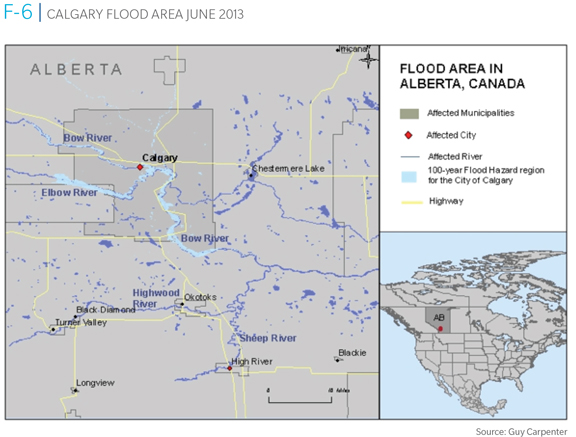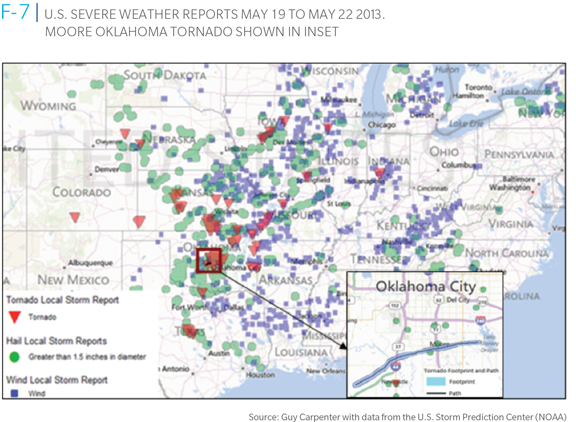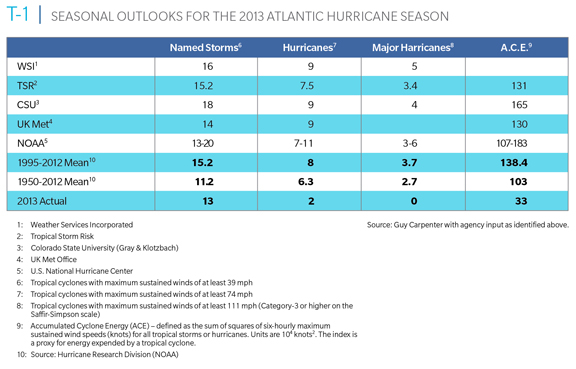
As with Europe, 2013 was a year of flood in the Americas, with notable events in Alberta, Toronto and Colorado. The flood event in the Calgary, Alberta area of Canada resulted in estimated insured losses of around USD2 billion, with economic losses of USD4.8 billion (1). This event, combined with flash-flooding in Toronto, Ontario in July, meant Canada experienced its most expensive insured catastrophe loss year on record.

Despite a very quiet 2013 tornado season in the United States, there were a handful of severe tornado outbreaks throughout the year. Most notable among these was the U.S. severe weather outbreak in May that affected the Southeast, Midwest and Southern Plains. This outbreak triggered the devastating Moore, Oklahoma tornado, rated as an EF-5 tornado on the Enhanced Fujita Scale. Moore, Oklahoma is located adjacent to Oklahoma City. Insured losses for this event reached USD1.8 billion (2). Another outbreak struck shortly after the Moore event at the end of May, affecting the Midwest and Southern Plains on this occasion. This outbreak included the El Reno tornado, with Doppler-estimated wind speeds near 295 mph (475 km/hr) above the ground. Insured losses for this event were estimated at USD1.4 billion (3).
Other severe convective outbreaks included storms in March that affected the Southeast and Lower Mississippi valley, with estimated insured losses of USD1.6 billion (4). A late-season outbreak impacting the Midwest and Ohio Valley resulted in insured losses of USD930 million (5). Such outbreaks are infrequent but not rare or unprecedented.
Other notable events of 2013 included a winter storm affecting the U.S. interior from April 7 to April 11, causing estimated insured losses of USD1.2 billion (6).

Meanwhile, the 2013 Atlantic Hurricane season was one of the most inactive on record. The most impactful events of the 2013 hurricane season were the landfalls of Hurricane Ingrid (Atlantic) and Tropical Storm Manuel (Pacific) in Mexico in September. These storms caused excessive rainfall, flooding and mudslides. Thousands of people were displaced. Combined estimated insured losses for Ingrid and Manuel totaled USD920 million, according to the Mexican Association of Insurance Institutions.
Only five other seasons since 1970 have had less activity than 2013. The quiet season was due to persistent dry, stable air over large portions of the Atlantic main development region. Tropical cyclones require moist, unstable air for development and this was not sufficiently enabled for much of the 2013 season.
The inactive season was unexpected given statistical forecasts for above-average activity provided by seasonal outlook providers. These providers included the team led by Dr. Bill Gray and Dr. Phil Klotzbach at Colorado State University (CSU), Weather Services Incorporated (WSI) and the U.S. National Hurricane Center (NHC). Statistical methodologies differ from agency to agency and incorporate features such as the Atlantic Multidecadal Oscillation (AMO), ENSO and sea-surface temperatures (SST) in the Atlantic main development region. Such indicators provide statistical guidance that surpasses simple averaging, but these techniques do occasionally fail.
Statistical indicators predicted an active 2013 season, and this simply did not materialize. Research into the physical reasons for this anomaly is ongoing by experts in the field. Gray and Klotzbach (CSU) theorize that an intermittent shift in the Atlantic thermohaline circulation, together with the corresponding response of the atmosphere and winds, resulted in dry, stable conditions over the Atlantic main development region. Statistical techniques to detect and leverage such behavior for improved predictability are being developed by the scientific community.

There is no guarantee that the 2014 Atlantic hurricane season will be like the 2013 season. We are still in an active phase of the AMO and we should remain in an ENSO neutral phase through the coming summer, according to the NOAA Climate Prediction Center (CPC). This indicates basin activity should meet or perhaps exceed the long-term mean. Landfalls are predicted by weather during the lifecycle of a tropical cyclone and cannot be reliably predicted on a seasonal basis. ENSO predictions will have to be monitored for the possible emergence of a weak El Niño, which would merit the re-evaluation of estimated tropical cyclone activity for the North Atlantic basin.
Despite the long-term active phase of the AMO, it is interesting to note that only four seasons in the Atlantic have seen basin activity exceeding the long-term mean since 2005. Only one of these seasons has seen U.S. landfalls exceeding the long-term mean (this does not include Sandy, which was classified as a post-tropical cyclone at landfall by the NHC).
With a neutral ENSO phase predicted by the NOAA CPC through the summer of 2014, there is no statistical reason to expect that U.S. severe weather activity should be lower than average. Significant variability from year to year is to be expected for such activity. The tornado events of the very active 2011 season are not unprecedented in history (7). Such outbreaks have occurred before - in 1974, for example - and such outbreaks will occur again.
Of great concern is the water situation in the state of California. According to NOAA, 2013 had the lowest precipitation in recorded history for California. Snowpacks are also at 30 percent or less of average for this time of year. This has already led to exceptionally severe drought conditions in the state. Impacts to water resources, agriculture and an aggressive wildfire season are therefore areas of concern for 2014.
Notes:
1. Swiss Re News Release, December 18, 2013.
2. PCS Catastrophe Bulletin No. 14. PCS - http://my.verisk.com/2013YearinReview?source=gc
3. PCS Catastrophe Bulletin No. 15. PCS - http://my.verisk.com/2013YearinReview?source=gc
4. PCS Catastrophe Bulletin No. 93. PCS - http://my.verisk.com/2013YearinReview?source=gc
5. PCS Catastrophe Bulletin No. 29. PCS - http://my.verisk.com/2013YearinReview?source=gc
6. PCS Catastrophe Bulletin No. 96. PCS - http://my.verisk.com/2013YearinReview?source=gc
7. Doswell, C.A., Carbin, G.W., Brooks, H.E., 2012: The tornadoes of Spring 2011 in the USA: an historical perspective. Weather. 67 (4), 88-94.